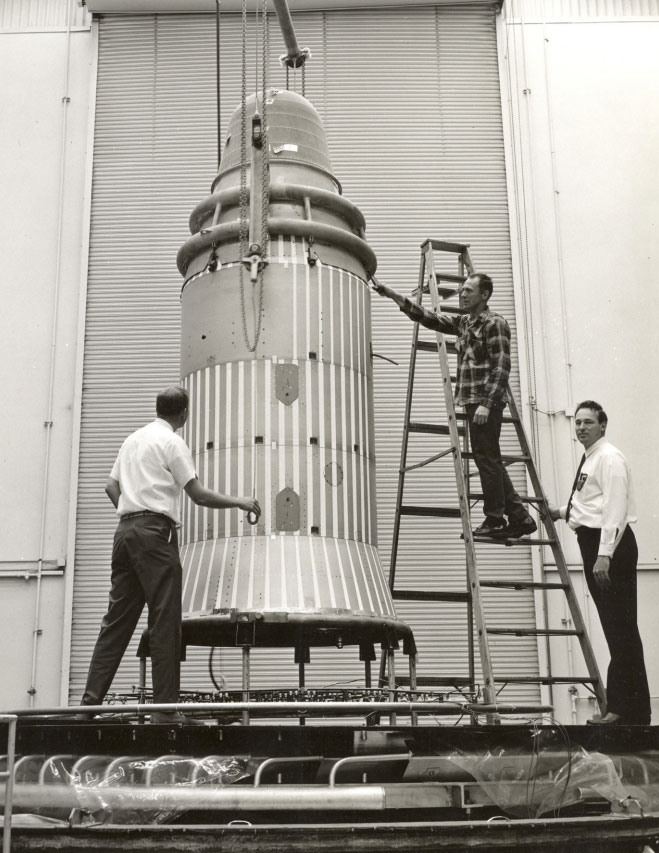 Engineers Ready Corona (Photo/CSNR Reference Collection)
Engineers Ready Corona (Photo/CSNR Reference Collection)
In January 1956 President Eisenhower established the President’s Board of Consultants on Foreign Intelligence Activities (PBCFIA), a predecessor of today’s President’s Intelligence Advisory Board. It included members of the TCP, including Killian, who chaired the board, and Land. By this time, the Air Force’s WS-117L project included plans for a SIGINT payload, a payload in which film from an IMINT payload would be scanned and transmitted to ground stations, and a payload in which film would be returned to earth via a reentry capsule.
Killian and Land doubted it was possible to develop a scanning and readout imagery system with the needed resolution or data volume using the technology available at the time. They were also concerned with the pace of the program, which they believed was too slow to meet the threat presented by the Soviets. These issues came to a head in October 1957 when the PBCFIA issued its semi-annual report to the President, emphasizing the need for a faster approach that would provide an interim capability.
In December 1957 the two men met at the White House with Bissell; the President’s staff assistant, Brig Gen Andrew Goodpaster; and Maj Gen Bernard Schriever, head of the Air Force’s ICBM and WS-117L projects. They agreed that the best course of action was to break up the WS-117L project and concentrate on the film recovery approach as a separate “crash” effort. President Eisenhower approved this new program, Corona, on 7 February 1958. The downing of Powers’ U-2 two years later would provide yet another push for urgency in the Corona program.
The media had linked WS-117L to satellite reconnaissance shortly after the Sputnik launch, so President Eisenhower directed the Air Force to ostensibly kill the film recovery segment, and then secretly transfer it to the CIA. As with the U-2, using the CIA allowed the government to use the agency’s special contracting authorities and keep the effort classified, which was critical because of the continuing political sensitivity of overhead reconnaissance. Bissell was appointed to manage the program, and Ritland again joined him as his deputy, along with other members of the U-2 team. (Greer, 1973)
Corona, a complex system using new technology, proved challenging to develop. Twelve missions failed due to launch vehicle, satellite, or recovery system malfunctions. A thirteenth spacecraft was successful, but as a test vehicle, carried no film. The first fully successful mission was launched on 18 August 1960 and recovered the next day. The first mission returned with 3,000 feet of film (more than the entire U-2 program up to then), imaging 1.65 million square miles of Soviet territory.
 In-air recovery of a CORONA canister.
In-air recovery of a CORONA canister.
Corona was originally intended as a stopgap until more capable systems entered service. But the program proved so productive that it was kept in service for almost twelve years and 145 missions, the last being launched on 25 May 1972. The NRO operated several different versions of Corona during the program’s lifetime, introducing different camera systems and making incremental improvements. The earliest missions produced imagery with a ground resolution of 40 feet, using the KH-1 camera (KH denoted Keyhole, the name of the program’s security system). Later cameras, the KH-2 and KH-3, improved resolution to 10 feet. The KH-4, the final Corona camera system, ultimately produced imagery with 5-7 foot resolution. NRO also provided Corona with multiple film return capsules that extended the film capacity of each mission. (Ruffner, 1995, pp. xiv-xv)
Corona imagery showed that the Soviets had far fewer strategic missiles than was thought and dispelled the notion in the early 1960s of a “missile gap.” For the remainder of the Cold War, satellite IMINT, combined with SIGINT, consistently gave U.S. officials accurate estimates of how many missiles, bombers, and submarines the Soviet Union had at any point in time. The Corona program, along with most of its imagery, was declassified in 1995 by an executive order from President Clinton.